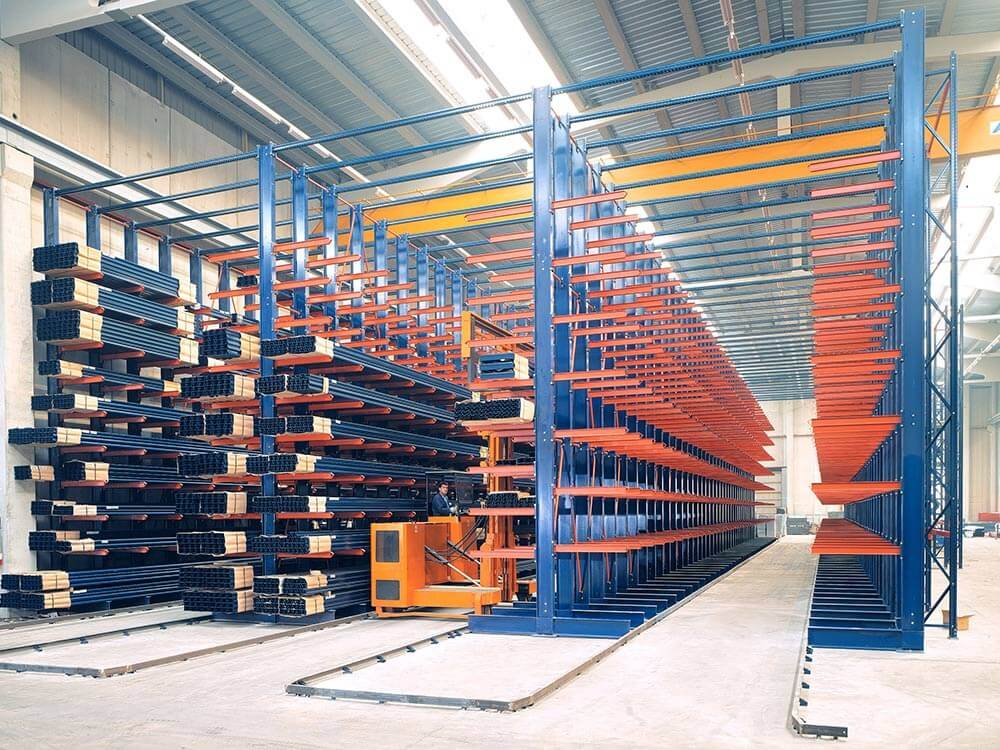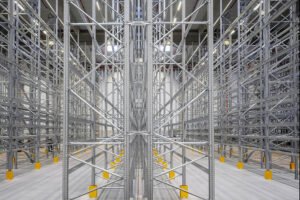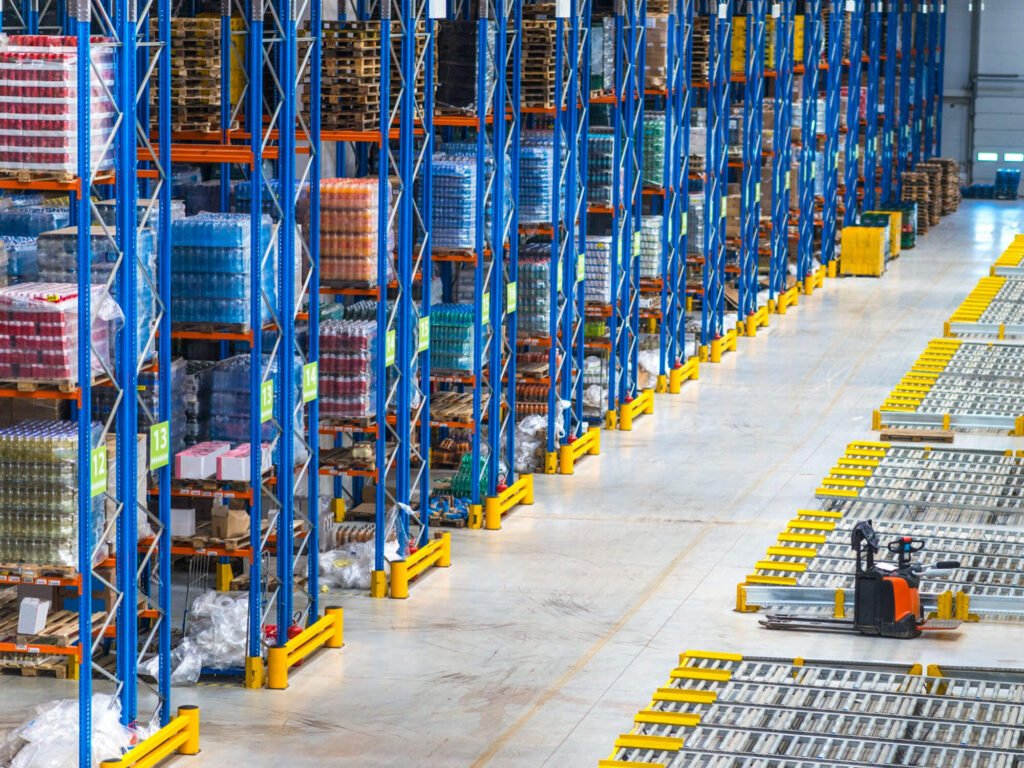Do you want your construction materials to keep the worksite organized? Oh yes! But storing everything properly can feel tricky. Don’t worry! Some storage methods are satisfactory. Also, they protect your materials and save your time.
In this article, you will learn the best ways of storing construction materials safely. Also, you will learn how to save space, reduce costs, and keep your site neat. Hence, you will know how to keep your materials protected.

Figure 1: Building Materials Storage
1) Why Proper Construction Materials Storage Matters
You need to store your construction materials properly. Because it protects your materials from damage. For example, Wood, metal, or cement can spoil if you don’t store them properly. After that, it keeps you and your workers safe. As well, cluttered or scattered materials can cause accidents. So by keeping them organized, you can make the space safer for everyone.

Figure 2: Why Proper Construction Materials Storage Matters
Also, proper storage saves you money. When your materials are safe. Then you don’t have to buy new materials again. Hence, it keeps your project on budget. Furthermore, it helps you complete the work on time. When everything is organized. Then you can easily find the things you need. So this keeps your project moving forward without stopping.
2) Common Types of Construction Materials
As you learn about Why Proper Storage of Construction materials matters. Now you will learn about Common Types of Construction Materials.
Figure 3: Common Types of Construction Materials
i) Wood and Timber: First of all, wood is easy to moisture and insects. If you leave it wet or exposed. Then it can rot or be eaten by insects. So you always store it in a dry and well-ventilated area. As well, if necessary, you can cover the wood or store it under a special sheet.
ii) Metal and Steel: Next, metal and steel can easily form rust. If you leave it in the rain or moisture. Then it can deteriorate. So you store it in a dry place and use a cover or anti-rust spray if necessary.
iii) Cement and Concrete: Then these materials spoil quickly with water. If you keep cement or concrete wet. Then it will harden and become useless. So you store it in a strong and dry container or a sealed place.
iv) Bricks and Blocks: After that, they are heavy and fragile. If you stack them without thinking. Then they can break. So you always stack bricks and blocks safely. Also, it is dangerous to store them at high altitudes.
v) Paints, adhesives, and chemicals: At last, these materials are sensitive and need to be protected. If you store them in a hot or humid environment. Then they can become damaged or dangerous. So you always store them in a safe and well-ventilated area.
3) Effective Storage Solutions
As you learn about the Common Types of Construction Materials. Now you will learn about an effective storage solution for your construction material.

Figure 4: Effective Storage Solutions
a) Indoor and Outdoor Storage
First of all, indoor storage is safe and dry. So your contents are protected from moisture, rain, and dust. On the other hand, outdoor storage is cheaper. But it requires you to use covers or sheets. Also, if you store outside. Then protect metal from rust, wood from moisture, and chemicals from deterioration.
b) Shelves and Racks
Next, Shelves and racks are the most important solution for your storage. When you have a lot of material. So if you use them correctly. Then they save space and keep the material safe.
- Steel Racks: First of all, steel racks are very strong and long-lasting. So you can use them for heavy metal, bricks, or large boxes. But you store them in a dry place so that they do not rust. As well, you can make the racks more secure with anti-rust spray or covers.
- Pallet Racks: Next, pallet racks are great for large and heavy materials. You can easily lift and place the materials with a forklift or hand truck. So they are useful for you in warehouses where a lot of material moves every day.
- Modular Racks: Then, modular racks are flexible. Also, you can make them bigger or smaller according to your needs. So if you have materials of different sizes. Then, modular racks are the best solution. Hence, you can easily attach or detach their parts, which gives you more freedom in storage.
Furthermore, you always place the materials on the racks according to their weight. So you place heavy items at the bottom. Then the light items at the top. So this will keep your racks sturdy and reduce the risk of damage to your materials. Also, space the materials on each shelf or rack at a distance. So you can easily lift the items, and there is also air circulation.
c) Bins, Containers, and Lockers
Then you use bins and lockers for small items or hazardous materials, such as chemicals. Also, they keep your materials organized. And also, you prevent accidental damage or accidents.
d) Climate-controlled storage
After that, if you have moisture- or temperature-sensitive materials. For example, paints or chemicals. So you always use climate-controlled storage. This storage protects the materials from spoilage and keeps them safe.
e) Stacking and organization techniques
At last, you always stack materials securely. Also, you keep heavy items at the bottom and light items at the top. And you keep similar items together. So this will make better use of your space and prevent damage to the materials.
4) Safety Measures for Material Storage
As you learn about an effective storage solution for your construction material. Now you will learn Safety Measures for the Storage of Materials.

Figure 5: Safety Measures for Material Storage
- Proper labeling and signage: First of all, you clearly label each material. So this will help you know what each item is and where to store it. As well, you put up special signs for hazardous materials to avoid accidents. Hence, this will help you and your team know everything right away.
- Protective covers, tarps, and pallets: Next, you cover the material with covers or tarps to protect it from dust, rain, or sun. Also, you use pallets to keep your material off the ground. So this will protect it from moisture and dirt. Hence, it will also protect your material from minor ground damage, such as water or insects.
- Fire and ventilation measures: Then you keep fire extinguishers and fire extinguishers on hand to prevent fire. Also, you keep the area where chemicals or paints are stored well-ventilated. So this will help to vent out toxic fumes and dangerous vapors. Moreover, you make sure that a fire extinguisher is easily accessible at all times.
- Keep aisles clear: After that, you should always keep your storage aisles clear and uncluttered. So this allows you to easily move materials and safely exit in an emergency. As well, these aisles make it easier and faster for your workers to work.
- Weight and stacking: At last, you always stack materials correctly. So heavier items are at the bottom and lighter items are at the top. Also, improper stacking can cause racks to fall or damage the materials. Hence, this way, you can avoid accidents and keep the materials safe.
5) Inventory Management & Tracking
As you learn about the Safety Measures for your Storage of materials. Now you will learn about the Inventory Management & Tracking of your construction material storage.

Figure 6: Inventory Management & Tracking
- First-in, first-out (FIFO) method: First of all, you use the oldest materials first. So this prevents waste and prevents spoilage. For example, if you bought cement or paint earlier. Then you use them first.
- Regular stock audits and tracking: Next, you check your materials periodically. Then see if anything is running out or spoiling. So this allows you to immediately address the problem and avoid additional losses.
- Using software: Then, you can track materials using software on your computer or mobile device. Also, it shows you where everything is and how much is left. So this makes your work easier and faster.
- Labeling and record keeping: After that, you apply clear labels to each material and keep records. So this gives you immediate information about everything.
- Determine reorder points: Furthermore, you always know when to order new materials. As well, this guarantees that you always have the necessary materials and that the work continues without stopping.
- Keep damaged or waste materials separate: At last, you keep damaged or waste materials in a separate place. So this prevents confusion in your storage. And also, allows you to use only the right materials.
6) Cost-Saving Strategies
As you learn about the Inventory Management & Tracking of your construction material storage. Now you will learn bout cost-saving strategies for your construction material storage.

Figure 7: Cost-Saving Strategies
i) Bulk storage vs. Just-in-time delivery: First of all, if you buy and store more materials at once. Then the cost can be lower. This is called bulk storage. However, you will need space and proper storage. On the other hand, you order materials when they are needed. Hence, this saves your storage space, and materials are not wasted. Also, you choose the best method according to your project.
ii) Recycle and reuse leftover materials: Next, you do not always throw away leftover materials. Wood, metal, or bricks can be reused. So this saves you money. As well, it is also good for the environment.
iii) Secure storage to prevent theft and damage: Then, you always store your materials in a secure place. Also, you use sturdy racks for storage. Hence, this not only stops theft but also reduces accidental damage.
iv) Planning and purchasing: After that, you always plan in advance which materials will be needed and when. So this will help you avoid unnecessary purchases. And also, you ensure that everything is available on time.
v) Energy and Resource Saving: At last, you use lighting and other resources wisely in your storage. Also, you can adopt energy-efficient methods to reduce your electricity and other resource costs.
7) Common Mistakes to Avoid
As you learn bout cost-saving strategies for your construction material storage. Now you will learn about common mistakes to avoid.

Figure 8: Common Mistakes to Avoid
? Placing materials directly on the ground: First of all, when you leave materials on the ground. Then it can cause them to deteriorate due to moisture and soil effects. So you always use pallets or racks to keep materials off the ground.
? Neglecting weather or moisture protection: Next, your wood, cement, and chemicals can deteriorate due to rain, sun, or moisture. So you use covers, tarps, or climate-controlled storage.
? Improper stacking and overloading: Then, your improperly stacking racks can cause materials to break. Hence, you put heavier items on the bottom and lighter items on top.
? Storing incompatible materials together: After that, your materials can be damaged or dangerous if stored together. For example, you don’t store chemicals near metal or other sensitive materials.
? Not doing regular inspections: At last, you check your storage space periodically. So this ensures that everything is safe. Hence, you can prevent potential hazards.
Conclusion
In short, proper storage keeps your materials safe and stops accidents. Also, it helps you to save money. So you always pay attention to labeling, racks, climate control, and stock tracking.
Furthermore, we at Lracking offer you strong and secure rack and storage solutions to make your work easier and safer. Also, you can contact us today for an order or more information.




